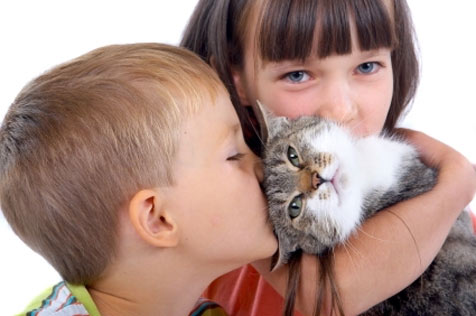Be Kind to Animals
Teach Children to be Kind to Critters

May is National “Be Kind to Animals” month. In honor of this month, show your children how to be caring and respectful toward all animals.
The Home
If you have a companion animal, be sure you give your pet lots of love and attention. Food, water, and shelter are the necessities, but your pet needs more than that. Aside from these basics, it’s pertinent that you schedule play times with your pet and your child so you can teach appropriate ways to play. If you have a rabbit, for example, make sure your child knows to never pull on the ears or tail and be shown the proper way to hold your bunny. If you have a guinea pig, you can sit on the floor with your legs stretched out and your feet touching your child’s; let the guinea pig run around between you both. Your child can also help walk the dog (with your assistance) and he or she can take part in playing with feather toys with the cat.
Teach your child that all animals are important. If you see a spider in your home, the first instinct may be to kill it. But if the spider isn’t poisonous, is this really necessary? Besides, spiders take care of other insects that we don’t really want in our homes. So with this in mind, show your child you care by scooping the spider up in a cup and taking it outside. You can do the same with all insects you find in your home. If you find mice droppings in your house, to catch the mouse with a humane live trap. Once the mouse is caught, you can let it go outside and be sure to seal all entryways so the mouse doesn’t get back into the house.
What if a bat gets inside? Contrary to myth, bats won’t get tangled in your hair and chances of them being rabid are miniscule. Bats consume more than 1,000 mosquitoes in an evening, so many people build bat houses to encourage them to settle in their yards. If one enters your home, turn off all the lights and open doors and windows. Bats are very sensitive to air currents, so the bat should leave on its own. If the bat still doesn’t leave after opening all doors and windows, catch the animal in a net. Always wear gloves if you attempt to handle a bat and be careful when releasing it outdoors. You can always call animal control if you need assistance, but killing the bat isn’t necessary and your child will learn to be compassionate if you handle the situation humanely.
The Outdoors
Santa Barbarans love their gardens! But if they comes at the expense of rabbits, gophers, or other animals, are we teaching our children that flowers are more important than another life? There are many ways to humanely deter animals from your garden. The best way to keep animals out is to erect a chicken wire fence at least 36″ above the ground and 12″ below the ground. Bend the underground portion away from the garden in an “L” shape. This will prevent animals from burrowing under the fence. Draping nylon netting across the plants also helps. You can place mesh cages over young plants and sink bottles into the ground allowing the wind to blow across them, creating a noise deterrent. Motion-activated noisemakers, available from garden centers, along with owl decoys and pin wheels are all effective deterrents.
Don’t use pesticides or fertilizers on your lawn. Not only are these chemicals poisonous to animals, they’re toxic to humans as well. Go organic if you want to control weeds and fertilize your plants. There are many all natural products on the market that won’t cause damage to animals or humans. Your child will learn at an early age that there are natural, nontoxic ways to control pests in the yard.
If your child is celebrating his or her birthday, it’s lovely to celebrate with a picnic in the park But are those birthday balloons really necessary? If just one balloon breaks free, it can drift into our oceans and end up in a turtle’s stomach. Sea turtles often mistake balloons for jellyfish and unwittingly become sick from the balloon and often die a slow death. Think about asking guests to bring a children’s book as a gift instead of a balloon.
At the grocery store do you ask for paper or plastic? Show your child you care about wildlife by opting for paper bags over plastic. Paper is best because birds, turtles, and dolphins often get tangled in and swallow plastic grocery bags. And if you want to be environmentally responsible, bring your own bag.
Finally, nature hikes are a great way to get children to connect with nature and animals. However, tadpoles, insects, and other tiny creatures should be left in their natural homes rather than disrupting and destroying their niche in the ecosystem by bringing them home as a pet. Wild animals should remain in the wild.
By teaching children at a young age to love and respect all animals, you will be instilling in them a compassionate and more fulfilling way of life.



